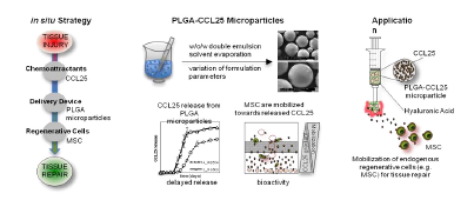Acta Biomaterialia ( IF 9.4 ) Pub Date : 2018-02-02 , DOI: 10.1016/j.actbio.2018.01.036
Kristin Fröhlich , David Hartzke , Franziska Schmidt , Jan Eucker , Aleksander Gurlo , Michael Sittinger , Jochen Ringe

|
Chemokines are guiding cues for directional trafficking of mesenchymal stem cells (MSC) upon injury and local chemokine delivery at injury sites is an up-to-date strategy to potentiate and prolong recruitment of MSC.
In this study we present the chemokine CCL25, also referred to as thymus-expressed chemokine, to mobilize human MSC along positive but not along negative gradients. We hence proceeded to design a biodegradable and injectable release device for CCL25 on the basis of poly(lactic-co-glycolic acid) (PLGA). The conducted studies had the objective to optimize PLGA microparticle fabrication by varying selected formulation parameters, such as polymer type, microparticle size and interior phase composition. We found that microparticles of DV,50∼75 µm and fabricated using end-capped polymers, BSA as carrier protein and vortex mixing to produce the primary emulsion yielded high chemokine loading and delayed CCL25 release. To determine bioactivity, we investigated CCL25 released during the microparticle erosion phase and showed that deacidification of the release medium was required to induce significant MSC mobilization.
The designed PLGA microparticles represent an effective and convenient off-the-shelf delivery tool for the delayed release of CCL25. However, continuative in vivo proof-of-concept studies are required to demonstrate enhanced recruitment of MSC and/or therapeutical effects in response to CCL25 release microparticles.
STATEMENT OF SIGNIFICANCE
With the discovery of chemokines, particularly CXCL12, as stimulators of stem cell migration, the development of devices that release CXCL12 has proceeded quickly in the last few years. In this manuscript we introduce CCL25 as chemokine to induce mobilization of human MSC. This study proceeds to demonstrate how selection of key formulation parameters of CCL25 loading into PLGA microparticles exerts considerable influence on CCL25 release. This is important for a broad range of efforts in in situ tissue engineering where the candidate chemokine and the delivery device need to be selected carefully. The use of such a cell-free CCL25 release device may provide a new therapeutic option in regenerative medicine.
中文翻译:

具有生物可吸收微粒的趋化因子CCL25的延迟释放,用于动员人间充质干细胞
趋化因子是在损伤后定向转运间充质干细胞(MSC)的指导线索,在损伤部位局部趋化因子的递送是增强和延长MSC募集的最新策略。
在这项研究中,我们提出了趋化因子CCL25(也称为胸腺表达趋化因子),使人类MSC沿正梯度而不是负梯度动员。因此,我们基于聚(乳酸-共-乙醇酸)(PLGA)设计了一种用于CCL25的可生物降解和可注射的释放装置。进行的研究旨在通过改变所选的配方参数(例如聚合物类型,微粒尺寸和内相组成)来优化PLGA微粒的制备。我们发现D V,50的微粒大约75 µm,并使用封端聚合物,BSA作为载体蛋白并涡旋混合以产生初级乳液进行制备,从而产生较高的趋化因子负载量并延迟了CCL25的释放。为了确定生物活性,我们研究了在微粒侵蚀阶段释放的CCL25,并表明释放介质的脱酸作用需要诱导显着的MSC动员。
设计的PLGA微粒代表了CCL25延迟释放的有效便捷的现货供应工具。但是,需要进行连续的体内概念验证研究来证明增强的MSC募集和/或响应CCL25释放微粒的治疗效果。
重要性声明
随着趋化因子,特别是CXCL12作为干细胞迁移的刺激物的发现,释放CXCL12的设备的开发在最近几年迅速进行。在本手稿中,我们介绍CCL25作为趋化因子来诱导人MSC的动员。这项研究旨在证明如何选择载于PLGA微粒中的CCL25关键配方参数如何对CCL25的释放产生重大影响。这对于需要仔细选择候选趋化因子和递送装置的原位组织工程中的广泛努力非常重要。这种无细胞的CCL25释放装置的使用可以为再生医学提供新的治疗选择。

































 京公网安备 11010802027423号
京公网安备 11010802027423号